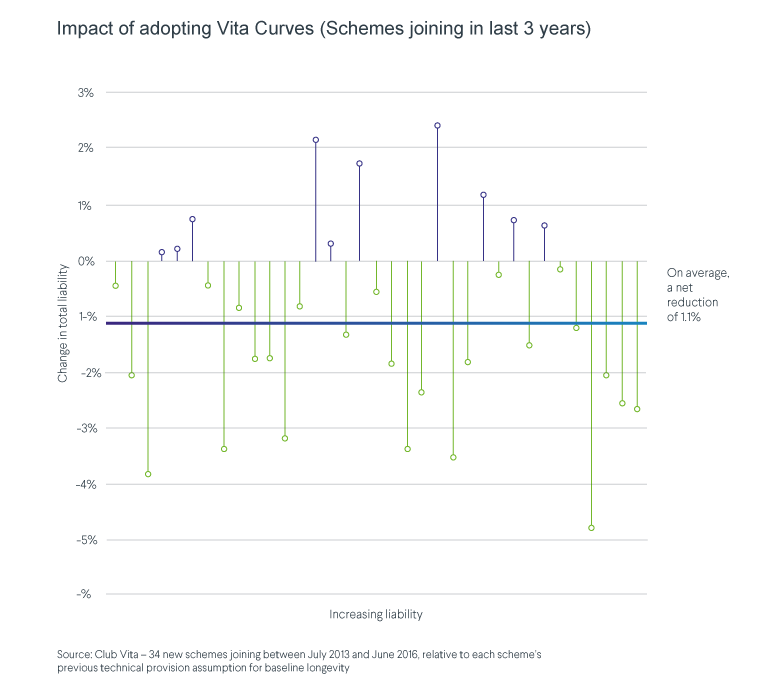19 January 2017
Key points:
- An over-valuation of how long people are likely to live is equivalent to continuing to pay everyone’s pension for 4 months after they’ve passed away;
- Companies with 2017 valuations could face bigger cash calls to shore up deficits than necessary. Given low interest rates, this has the potential to tip some funds into closing;
- Hedging out the uncertainty in future longevity trends becomes more affordable than many trustees think, and is now more accessible to smaller pension funds.
The trustees of the UK’s defined benefit (DB) pension funds could reduce the collective UK deficit by £25bn* by using more accurate assumptions on longevity.
With rock-bottom interest rates causing pension deficits to swell, trustees and sponsors of defined benefit pension funds need to avoid unnecessary margins in assumptions. Companies with funds facing record funding deficits in 2017 valuations will be feeling the heat. They, and fund trustees, should look at whether they’re taking an unnecessarily prudent approach. It could be distorting important decisions on the future strategy of their funds.
Analysis from Club Vita, which pools the longevity data of over 200 DB funds and insurers, shows that trustees are typically still taking unnecessary margins in setting their longevity assumptions. For the latest DB funds to join Club Vita, the chart below shows the change in valuation of each fund's liabilities from swapping the trustees’ previous assumptions for Club Vita’s best estimate assumptions, known as VitaCurves. Increases in the value placed on the fund's future liabilities are shown in red, whilst reductions are shown in green.

Commenting on the analysis, Douglas Anderson added:
“When we take on a new fund, on average there’s an over-valuation of liabilities of around 1%, with several funds enjoying far larger reductions to their deficits. The 1% average reduction is equivalent to continuing to pay everyone’s pension for 4 months after they have passed away. If the same pattern was seen across all the UK’s defined benefit pension funds, then deficits could fall by £25bn by adopting Club Vita’s methodology*. You might have expected that bigger funds would be better at assumption-setting than smaller funds but that’s not so, with several £1bn+ funds overestimating liabilities by substantial amounts.”
Explaining what’s causing the over-valuation in longevity he added:
“Having helped almost 250 funds get a better handle on longevity risk over the last decade, we’ve observed three main causes. First, using final salary (as well as postcode) as a predictor of longevity refines the valuation of mid-sized pensions. Under the traditional approach, you don’t know whether a typical £5,000 annual pension relates to a long-serving, low-salary person or a short-service, high-salary person – two people who would have very different life expectancies.
“Second, the data underpinning Club Vita’s survival tables is fresher than the CMI tables typically used by funds and captures heavier mortality in recent years. For example, the 2016 VitaCurves data is based on 2012-2014, compared to CMI S2 tables which use data from 2007. Finally, when adjusting “standard” CMI tables, there is a natural behavioural bias to err on the side of caution in the face of uncertainty. VitaCurves capture a wider spectrum of diversity of our population than CMI tables (shown by the 10 years range of life expectancies rather than 5 years for CMI), reducing the need for subjective, manual adjustments.”
“Naturally, the ultimate cost of a pension fund will be determined by how long its members actually live. But assumptions made today really do matter for such long duration commitments. The confidence that trustees gain from more insightful longevity assumptions does change behaviours, affecting members’ benefits, their security and businesses’ ability to invest.”
Explaining how managing longevity risk is no longer the preserve of larger funds he added:
“Rightly, we have seen longevity management move higher up funds’ agendas. With DB funds maturing and investment risk being dialled down, longevity is now a bigger risk than ever before. Fortunately, hedging out the uncertainty in future longevity trends may be more affordable than many trustees think. This is particularly relevant now that longevity insurance is available to smaller pension funds through innovations like Club Vita’s VitaHedge service. Until fairly recently, insurers were only confident to offer attractive prices to the biggest funds, but that’s now starting to change. Given a combination of increasing costs of longevity risk and improved access in the market, we expect many more funds to take proactive steps to manage longevity risk in 2017.”
*This analysis is based on the liabilities of UK defined benefit pension funds, as measured on a buyout basis, standing at £2.4trillion according to Hymans Robertson’s 3DAnalytics, which tracks the funding position of all UK pension funds.
All funds that have joined Club Vita over a three year period have been included in this analysis. This sample of funds come from diverse industrial sectors and actuarial advisors.
Allowances for future improvements in longevity – where trustees typically put their margins for prudence – have been stripped out. This analysis looks at differences in “baseline” longevity, reflecting the trustees’ best estimate of today’s survival patterns for their members.
Find out more
Find out how our unparalleled insights can benefit your fund



